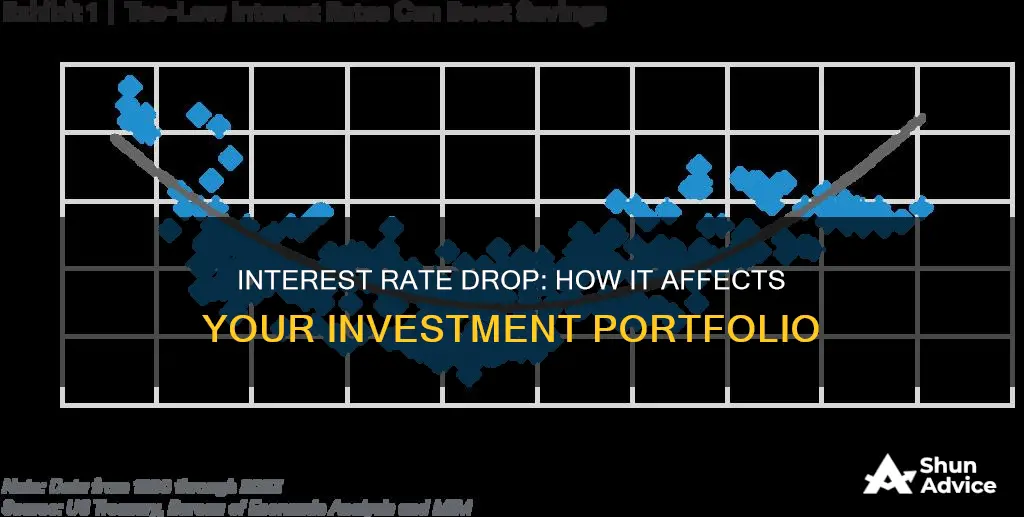
When interest rates fall, it can significantly impact investment strategies and the broader economy. Lower interest rates often lead to increased borrowing and spending, as the cost of borrowing money becomes more attractive. This can stimulate investment in various sectors, such as real estate, stocks, and business expansion. However, it may also lead to concerns about inflation and the potential for asset bubbles. Understanding these effects is crucial for investors and policymakers alike, as it can influence decision-making and the overall health of the financial market.
What You'll Learn
- Impact on Borrowing: Lower rates encourage more borrowing, increasing investment demand
- Asset Prices: Falling rates often lead to higher asset prices, attracting investors
- Consumer Spending: Reduced costs prompt increased consumer spending, boosting investment
- Business Investment: Businesses may invest more due to lower financing costs
- Stock Market: Interest rate drops can stimulate stock market activity and investment

Impact on Borrowing: Lower rates encourage more borrowing, increasing investment demand
When interest rates fall, it has a significant impact on borrowing behavior and investment patterns. One of the most direct effects is the encouragement of more borrowing. Lower interest rates make borrowing cheaper, which can be a powerful incentive for individuals and businesses alike. This is particularly true for long-term borrowing, such as mortgages or business loans, as the cost of repayment becomes more manageable over time. As a result, people may be more inclined to take out loans for various purposes, such as purchasing homes, starting businesses, or funding personal projects.
This increased borrowing activity has a direct impact on investment demand. When more people and entities borrow, they often channel those funds into investments, whether it's buying stocks, expanding business operations, or acquiring assets. The lower interest rates create a favorable environment for investment, especially for those who were previously deterred by higher borrowing costs. This surge in investment demand can drive up asset prices and stimulate economic growth.
For businesses, lower interest rates can mean the difference between a viable project and one that is financially unfeasible. With reduced borrowing costs, companies may be more willing to invest in research and development, infrastructure, or expansion plans. This increased business investment can lead to job creation, innovation, and overall economic prosperity. Additionally, lower interest rates can encourage businesses to take on more debt, which, when channeled into productive investments, can have a positive ripple effect on the economy.
The impact on borrowing and investment is further amplified in the housing market. When interest rates fall, mortgage rates tend to follow suit, making home loans more affordable. This can lead to a surge in housing demand as more people can qualify for mortgages. As a result, the housing market becomes more active, with increased construction, higher property values, and a boost in related industries. This, in turn, creates a positive feedback loop, encouraging further borrowing and investment in the housing sector.
In summary, lower interest rates have a profound effect on borrowing behavior, making it more attractive and affordable. This, in turn, drives up investment demand, as individuals and businesses seek to capitalize on the favorable financial environment. The impact on borrowing and investment can lead to economic growth, job creation, and increased asset values, making it a crucial factor to consider when analyzing the broader implications of interest rate changes.
Unleash Your Inner Investor: Exploring Prior Interests in the Stock Market
You may want to see also

Asset Prices: Falling rates often lead to higher asset prices, attracting investors
When interest rates fall, it often triggers a ripple effect across various sectors of the economy, particularly in the investment landscape. One of the most notable impacts is on asset prices, which tend to rise as a result of lower borrowing costs and increased liquidity in the market. This phenomenon is a direct consequence of the relationship between interest rates and the cost of capital.
Lower interest rates make borrowing cheaper, encouraging businesses and individuals to take on more debt. This increased borrowing power leads to higher demand for assets, such as stocks, real estate, and commodities. As demand rises, so do the prices of these assets, creating an attractive environment for investors. For instance, during periods of falling interest rates, the stock market often experiences a surge in investor confidence, leading to higher stock prices and potentially increased investment returns.
The reason behind this behavior is rooted in the concept of present value. When interest rates are low, the present value of future cash flows increases, making investments more appealing. Investors are willing to pay more for assets that offer the potential for future growth, especially when the cost of borrowing is reduced. This shift in investor sentiment can drive asset prices higher, creating opportunities for those who enter the market during such periods.
Additionally, falling interest rates can stimulate economic activity, further fueling the rise in asset prices. With lower borrowing costs, businesses may expand their operations, leading to increased production and potentially higher profits. This, in turn, can drive up the prices of company stocks and other equity-related assets. Real estate markets also benefit as lower interest rates make mortgage payments more affordable, encouraging more people to buy properties, thus increasing demand and prices.
In summary, when interest rates fall, the resulting lower borrowing costs and increased liquidity often lead to a surge in asset prices. This trend attracts investors who seek to capitalize on the potential for higher returns. Understanding this relationship is crucial for investors looking to navigate the market effectively during periods of changing interest rates.
Unlocking Global Growth: Navigating High-Interest Rate Investments
You may want to see also

Consumer Spending: Reduced costs prompt increased consumer spending, boosting investment
When interest rates fall, it often triggers a chain reaction in the economy, particularly in the realm of consumer spending and investment. One of the most significant impacts is the reduction in borrowing costs for individuals and businesses. Lower interest rates mean that loans, mortgages, and credit card debt become more affordable, which directly influences consumer behavior. As a result, consumers are more inclined to spend, as their disposable income increases due to reduced interest payments. This surge in consumer spending is a powerful engine for economic growth.
The relationship between interest rates and consumer spending is intricate. When interest rates are low, the cost of borrowing is decreased, encouraging people to take out loans for various purposes, such as purchasing homes, cars, or starting businesses. This increased borrowing activity stimulates the economy as a whole. For instance, a homeowner might take out a mortgage at a lower interest rate, making it more financially viable to invest in a property. Similarly, businesses may be more inclined to expand their operations or invest in new projects when borrowing becomes cheaper.
This increased spending and investment have a ripple effect throughout the economy. As consumers spend more, businesses experience higher demand for their products and services, leading to potential revenue growth. This, in turn, can encourage businesses to invest in their operations, hire more employees, and potentially expand their product lines or services. As a result, the overall investment in the economy increases, contributing to economic growth and development.
Moreover, the impact of lower interest rates on consumer spending is not limited to the immediate effects on borrowing and spending. It can also influence long-term financial planning. With reduced interest rates, individuals might feel more confident about taking on long-term financial commitments, such as saving for retirement or investing in education. This increased financial confidence can further boost consumer spending and contribute to a more robust investment climate.
In summary, when interest rates fall, the reduction in borrowing costs directly translates to increased consumer spending. This surge in spending stimulates economic activity, encouraging businesses to invest in expansion and potentially creating a positive feedback loop. As a result, the overall investment in the economy can grow, leading to a more prosperous and dynamic financial environment. Understanding these dynamics is crucial for investors, policymakers, and individuals alike, as it highlights the potential benefits of a falling interest rate environment.
Understanding Interest Accrual: A Guide to Semiannual Investment Growth
You may want to see also

Business Investment: Businesses may invest more due to lower financing costs
When interest rates fall, it can have a significant impact on business investment decisions. One of the most direct effects is on the cost of borrowing. Lower interest rates mean that businesses can secure loans at a reduced cost, making it more affordable to finance new projects, expand operations, or invest in research and development. This reduction in financing costs can encourage businesses to take on more debt, as the interest payments become less burdensome. As a result, companies may be more inclined to invest in long-term growth strategies, such as acquiring new assets, launching new products, or entering new markets.
The decreased cost of borrowing can also stimulate business investment by providing a sense of financial security and stability. With lower interest rates, businesses can plan for the future with more confidence, knowing that their debt obligations are manageable. This stability can lead to increased business activity and a more optimistic outlook, prompting companies to make strategic investments that could have a lasting impact on their operations.
Additionally, the relationship between interest rates and investment is often cyclical. When interest rates fall, businesses may become more willing to invest, which in turn can lead to economic growth. This growth can create a positive feedback loop, where increased investment further reduces interest rates, making it even more attractive for businesses to invest. As a result, lower interest rates can become a catalyst for a broader economic expansion.
However, it's important to note that the impact of falling interest rates on business investment is not solely positive. While lower rates can encourage investment, they may also lead to concerns about inflation and the potential for future rate increases. Businesses need to carefully consider their investment strategies and ensure that they align with their long-term financial goals and risk tolerance.
In summary, when interest rates fall, businesses often find themselves in a more favorable position to invest. The reduced cost of borrowing and increased financial stability can encourage companies to take on more debt and make strategic investments. This, in turn, can stimulate economic growth and create a positive environment for businesses to thrive and expand their operations.
Debt or Invest? Navigating the Financial Crossroads
You may want to see also

Stock Market: Interest rate drops can stimulate stock market activity and investment
When interest rates fall, it can have a significant impact on the stock market and investment behavior. This phenomenon is often associated with a period of economic expansion and lower borrowing costs, which can encourage investors to take on more risk. Here's how it works:
Lower interest rates make borrowing cheaper, which can lead to increased consumer spending and business investment. This is particularly beneficial for companies, as it becomes more affordable to finance projects, expand operations, and invest in growth. As a result, many businesses may see an upswing in their profitability, which can attract investors looking for potential gains. The stock market often reacts positively to such news, as investors anticipate higher earnings and improved financial performance.
Additionally, falling interest rates can make stocks more attractive compared to fixed-income securities like bonds. Bonds typically offer a fixed return, which may become less appealing when interest rates are low. In contrast, stocks can provide the potential for higher returns, especially if companies are able to grow their earnings. This shift in investor preference can drive more capital into the stock market, increasing trading activity and potentially driving stock prices higher.
The impact of lower interest rates on the stock market is not limited to individual stocks but can also affect various sectors and industries. Sectors like technology, consumer discretionary, and healthcare often benefit from lower borrowing costs as they tend to rely heavily on capital spending and research and development. These sectors may experience increased investment and market attention during periods of falling interest rates.
However, it's important to note that the relationship between interest rates and the stock market is complex and can vary depending on other economic factors. While lower interest rates can stimulate investment and market activity, they must be considered in the context of overall economic conditions, company-specific fundamentals, and global market trends. Investors should conduct thorough research and analysis to make informed decisions, especially when navigating the potential risks and rewards associated with interest rate changes.
Understanding Tax Implications: Is Investment Income Taxable?
You may want to see also
Frequently asked questions
When interest rates decrease, it often leads to a shift in investment patterns. Lower rates can stimulate the economy by making borrowing cheaper, which encourages businesses to invest in expansion and individuals to purchase homes or other assets. This increased investment activity can drive up asset prices, making it an attractive time for investors to buy.
Stock markets tend to benefit from falling interest rates, especially in the short term. Lower rates can lead to increased liquidity, making it easier for companies to raise capital through initial public offerings (IPOs) or bond issues. This influx of capital can boost stock prices, creating a favorable environment for investors.
Yes, there are potential risks. When interest rates fall, fixed-income investments like bonds may become less attractive as their yields decrease. This could lead investors to seek alternative investments, potentially causing a shift in market dynamics and affecting asset prices. Additionally, if rates remain low for an extended period, it might signal economic stagnation, impacting long-term investment strategies.
In the real estate sector, falling interest rates can stimulate demand for property. Lower mortgage rates make it more affordable for buyers, increasing the likelihood of purchases. This can drive up property values and create opportunities for investors in the short term. However, it's essential to consider the potential long-term effects of sustained low rates on the housing market.
Investors might want to consider a few strategies. Diversification is key, as different asset classes may react differently to falling rates. Reviewing and adjusting investment portfolios to align with the new economic environment is crucial. Additionally, staying informed about central bank policies and economic indicators can help investors make timely decisions regarding their investment choices.







